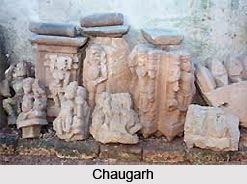Archaeological Sites of Medinipur district lay bare the various spots of archaeological importance as well as the places of interest in the eye of an historian. Medinipur district is much enriched in its archaeology. Social evolution has left its imprints in this region as before 15, 000, 00 years ago. Pre-historic features of this region can be proved from its Stone Age evidences, which are collected from the river-beds of Subarnarekha, Kansavati and Tarapheni.
Bankati is one site which falls under Sankrail PS of Jhargram sub-division. This place is of extreme historical importance as hundreds of weapon have been discovered here, which are of stone-age in dating back. Weapons made of quartzite and ageing to Neolithic period and Mesolithic age and small weapons of Mesolithic age are also found here. Weapons like pebble tool, scrapper and cutter have been discovered here.
 Chaugarh
Chaugarh
This site is under Gopiballavpur PS of Jhargram sub-division. Hundreds of stone weapon have been discovered here, most of the pebble tools are made of quartzite. Blades of Mesolithic age, scrappers and arrow-heads are made of chart stone. Pebble tools made of sand stone and dating to Neolithic age are also found here.
Chhototurki
This is a village in Gopiballavpur PS of Jhargram sub-division, where weapons dating back to Neolithic and Mesolithic ages have been found. Mesolithic weapons like blades scrappers and arrow heads are made of chart stone.
Dhansjol: This site is in Gopiballavpur PS of Jhargram sub-division where weapons of lower, middle and upper Palaeolithic ages are found. Weapons like axe, scrapper and cutter etc. made of quartzite are also available.
Dolki
This village is under Nayagram PS of Jhargram sub-division. Stone Age weapons are found here in a large number. These weapons are of lower-Palaeolithic age to Neolithic age. Lower Palaeolithic weapons made of quartzite and axe, arrow head, scrapper etc. are of higher Palaeolithic phase and made of chart stone. Middle Palaeolithic weapons like cutters, blades and arrow heads are made of same stone. An axe, made of sand stone, dating back to Neolithic age was also found here.
Ghoripincha
This site is in Gopiballavpur PS of Jhargram sub-division. Various types of stone evidences of lower Palaeolithic age to Neolithic age have been discovered here. Weapons like axe, cleaver and pebble tools are found here. Axe and arrow heads are made of quartzite and dating back to middle Palaeolithic age. Arrow head etc. of Neolithic age has been discovered here.
Hatibari
This site is in Gopiballavpur PS of Jhargram sub-division. Cutter weapons have been discovered here, which are dating back to lower Palaeolithic ages and made of quartzite. Neolithic pebble tools are also found here. Palaeolithic weapons are shaped as `U` and `V` letters. Weapons both of Abbevillian and Achullian types are found here.
 Hatimara
Hatimara
This site is in Gopiballavpur PS of Jhargram sub-division. Hand axes and cutters, made of quartzite dating back to lower Palaeolithic age and blade and scrapper, made of chart stone and dating back to middle Palaeolithic age and round shaped proto-evidence, made of sand stone, dating back to Neolithic age and chisel has been discovered here.
Jamagara: This site is in Gopiballavpur PS of Jhargram sub-division, where evidences of lower and middle Paleolithic ages have been found.
Karkata
This is a village in Binpur PS of Jhargram sub-division, where an important pre-historic site has been discovered. A great number of stone weapons came to collection from this place. These are mostly of Palaeolithic ages. No evidence of Neolithic phase was found here.
Kayasol
This is a village in Gopiballavpur PS of Jhargram sub-division, from where a good number of stone weapons have been discovered. Weapons of lower and middle Paleolithic and of Mesolithic ages have been found here.
Kele Jharia
This site is under Jhargram PS. Stone weapons of lower and middle Palaeolithic and Mesolithic phases are found here. Mesolithic weapons, such as scrappers, arrow heads, blades and triangular stone weapons have been found here. These chart stone weapons are very important.
Kurchibani
This site is in Nayagram PS of Jhargram Sub-division. Weapons of lower Palaeolithic and Mesolithic ages have been found here. These are of quartz stone and Mesolithic weapons are made of chart stone.
Kurumberia
This site is under Gopiballavpur of Jhargram sub-division. Remains of lower Palaeolithic and Mesolithic cultures have been discovered from this site. Cutters, blades and arrow heads of Mesolithic culture have been found here.
Macha Bandha
Evidences of Palaeolithic, Mesolithic and Neolithic ages have been discovered here. Hand axes, made of quartzite and dating back to lower Palaeolithic phase, have been discovered here. Among the Neolithic tools mention may be made of ring stone weapons.



















